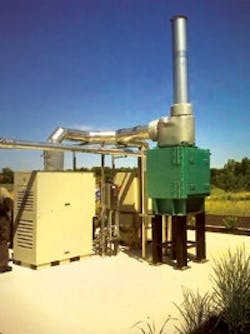Getting an Energy Boost With Biogas
As more U.S. wastewater treatment plants (WWTPs) attempt to reduce dependency on traditional fuels, the role of biogas produced on site is becoming an increasingly attractive alternative.
In wastewater treatment, biogas is a byproduct of the fermentation of organics that are separated and accumulated through the liquid side treatment, notably in primary and secondary clarifiers. Anaerobic digestion is the most common process used to produce biogas. Biogas itself is a combination of various compounds, mainly methane, carbon dioxide, nitrogen, hydrogen, hydrogen sulfide, moisture, and in some cases, a small fraction of organosilicon compounds.
Biogas from wastewater may require further treatment, cleaning or processing, depending on the intended end use. Also, because biogas yields a lower calorific value, its use without further conditioning or scrubbing is limited to in situ applications. The calorific value is a little more than 600 BTUs per cubic foot, and can be used in two broad applications: combustion to produce heat, power or both; and scrubbing to produce biomethane.
Biogas Utilization
Because biogas at WWTPs is a byproduct of anaerobic digestion, its most common utilization is for digester heating. This is accomplished using a dual fuel boiler that is capable of combusting biogas and natural gas. The natural gas supply acts as a backup during digester startup or times when the biogas production level is down due to low-quality organic substrate being fed to the digester. The biogas boilers tend to be robust and able to accept varying quality of biogas. They often require little or no biogas conditioning, and provide the most cost-effective method to recover energy from biogas. In most anaerobic digestion plants, the boiler acts as the single source of heat to the digestion process, which typically occurs at 98°F. In colder climates, boilers combusting biogas also can provide valuable room heating.
For many years, turbines have been adopted in WWTPs to produce both heat and power. The oldest known technology is the internal combustion engine, known as a reciprocating engine, which produces heat and, to a small extent, power. The heat is captured for process and room heating using water jackets around the engine and air-to-water heat exchangers at the engine exhaust. Reciprocating engine technology has undergone development, making it efficient and attractive to large WWTPs.
Gas turbines, both conventional and recuperated, are easy-to-maintain engines that also are commonly used in WWTPs. They have low electrical efficiencies as opposed to internal combustion engines, but have better thermal efficiency. These engines also are common in large WWTPs and are used to generate process and room heating in addition to electricity from biogas.
The microturbine is a popular choice in many new plants embracing the biogas-to-energy concept. Microturbines are small recuperated engines that are packaged to be easily installed and operated.
Most biogas engines produce electricity that is used within the plant. In some instances, the electricity is pushed back into the utility grid, although it is uncommon in the U.S.
All gas engines require a certain level of biogas conditioning. Most common conditioning and scrubbing systems include modules for removal of moisture, hydrogen sulfide and siloxane, an organosilicon compound that deposits on the moving part of engines and damages the internals. Numerous proprietary and nonproprietary materials are used to condition biogas for use in engines.
Producing Biomethane
Biogas can be scrubbed to remove carbon dioxide, hydrogen sulfite and other impurities to produce biomethane. Because methane is the main energy source, the purified gas can be used as a substitute for natural gas and pumped into the gas grid, in fuel cells or in natural gas-powered vehicles.
Scrubber biogas can be compressed and pumped into the natural gas supply line, offering a means of revenue to the WWTP.
Fuel cells use the hydrogen present in methane to convert chemical energy to electrical energy. Depending on the type of fuel cell used, the process might produce electricity or both electricity and thermal energy. Although fuel cells are a mature technology, they are relatively uncommon in the wastewater market.
The WWTP’s facility vehicles or local public transportation vehicles can be converted to accept compressed biomethane as an alternative to fossil fuels. This will save the plant operational expense and reduce carbon footprint.
In all, biogas is a valuable resource that is readily available to any plant with anaerobic digestion, and it can be used to reduce fossil fuel dependency and carbon footprint.
Download: Here
